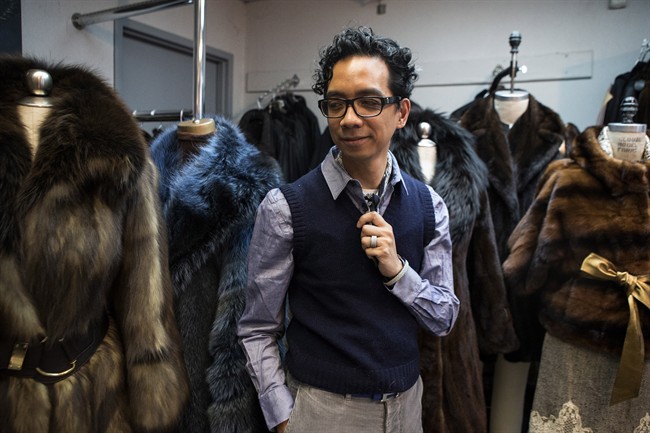TORONTO – When Drake wanted a pair of new fur coats to celebrate his birthday and graduation, the homegrown hip-hop star and unabashed Toronto booster turned to hometown designer Farley Chatto to outfit him in high-end style.

“Believe it or not he’s a regular client, we do a lot of work with him,” the affable Chatto said during a recent interview at Four Seasons Fur, where he is designer-in-residence.
He recommended Drake select a silver fox fur – reminiscent of styles worn by the rapper’s music industry peers – and Russian broadtail and chinchilla for “pure luxury.”
“Sure enough, he bought them both, wore them out in the city, and then wore them on ‘Saturday Night Live,”‘ said Chatto, referring to Drake’s recent stint on the sketch series as host and musical guest.
“It’s nice to see a Canadian promoting fur.”
When Chatto makes his return to the Toronto runway at World MasterCard Fashion Week on March 20, the showcase will feature luxury furs including mink, fox and chinchilla.
Chatto said items in the collection will range from $4,000 to $20,000 – the price for a Russian broadtail trimmed with Barguzin sable, which he described as the “top end” of the sable family.
If there are no interruptions, Chatto said it takes a little over a week to create one coat from start to finish, from prepping the skins to lining the garments. With a staff of around 10 people, Chatto said Four Seasons Fur is considered the largest Canadian fur manufacturer, with coat production numbering “easily in the hundreds.”
Chatto said his last official show in 2008 featured menswear. After seeing others incorporate bits and pieces of fur in their lines, he was motivated to return to the catwalk to show a full fur collection.
“Because Canada was founded on the fur industry, I thought what better way for: a) for me to come back – not that I was away – on the runway, and, b) to bring fur back to where it used to be – to its prominence.
“Fur is a beautiful, natural resource, and working in new shapes and new cuts, it definitely needed to be on the runway. Sometimes, it just loses it in a lookbook or a simple showroom setting.”
Sewing since he was 10 and in business for 26 years, the eternally youthful 44-year-old said menswear, tailoring and bespoke remain his main loves. But his interest in fur dates well back to his time in school.
While he still creates ready-to-wear garments, Chatto said the market has become “soft” and “oversaturated.” He has been working with Four Seasons Fur for the past several years and owner Angelo Papaevangelidis invited him to move in to the workspace.
Chatto works with Origin Assured furs, which means he can guarantee all furs are from North America or European countries that follow OA standards. Developed by the International Fur Trade Federation, furs bearing the OA label ensure that the garment is sourced from a country where local or national regulations or standards governing fur production are in place.
Despite the presence of such protocols, animal rights organizations like the People for the Ethical Treatment of Animals remain steadfastly opposed to the use of real fur in fashion. PETA will have representatives in attendance at World MasterCard Fashion Week, with details for their specific plans to be provided closer to their event date, a media liaison said in an email to The Canadian Press.
“PETA does frequently visit fashion weeks around the world to let attendees know that animals are not ours to wear, and that there are fantastic options for people who want to be stylish and cruelty-free, and those options do include faux fur, faux leather, wool alternatives,” said Ashley Byrne, a New York-based campaign specialist for the group.
Chatto said that fur is “the most green of all materials” and contends that the use of so-called “fun fur” is more damaging to the environment due in part to being a petroleum-based product.
“In order to get to make your fun fur, it’s mined, so therefore the Earth is stripped. And in order to do that, it’s processed. That means chemicals, pollutants go into the waters, into the air, into the land, and then to produce your garment,” said Chatto. “After you’re done wearing it, it gets thrown into the landfill and 200, 300 years later it stays exactly the same.
“Meanwhile, you buy a fur coat from me where the animals are treated humanely, their remains are usually left out in the wild for the other species to eat. It’s like the circle of life, they actually have a source of food. And generation after generation, the coats are passed down. Coats can last up to 50, 60 years. They can be reworked and remodelled.”
Byrne disputes the notion that the creation of faux fur is more environmentally harmful, saying that it takes “more than 15 times the energy” to produce a farmed fur coat than a synthetic faux coat.
Despite the controversy that continues to swirl around its use, many consumers continue to snap up fur garments – and not just within Canada. Chatto said they have sent coats to Hong Kong and London and worked with clients in the Middle East.
Chatto says their male clientele has “increased dramatically, with Drake a case in point.
“Wearing fur again, maybe (it’s) not as a full coat for some of them. Whether it’s a collar, whether it’s a scarf or maybe wearing a vest, they’re back in – and the younger, the better.”


Comments